MOJAVE

Rick is itinerant, as you know, so I'm letting him crash at my blog. He might get his own space someday, but I'll believe that when I see it. He might get a 9-to-5, too. Yeah. And cut his hair. Pigs might fly out of my butt. Anyway, I have no tolerance for freeloaders, so I'm making him contribute to our humble bloghold. This contribution stems from a comment he made on one of my posts about Las Vegas being "a cancer on the beautiful desert." I share that feeling. I became intrigued with the desert — I should say deserts; there are four in the U.S., and they are all very different — after reading a book by Jean Baudrillard called "America," in which he very memorably describes Salt Lake City and Las Vegas as the virgin and the whore fighting for dominance in America's great wasteland.
Las Vegas was my first experience of the desert. My dad took me there for my college graduation. Had I been a boy, he probably would have treated me to a prostitute at some rural hooker-ranch. My dad's like that. Instead, our only venture outside the air-conditioned casinos was a day trip to Hoover Dam. And the Mojave Desert scenery blew me away. There is something about being in a beautiful, hostile environment that makes you feel very tiny and very alive and very blessed to be alive. (My friend George has confided in me his desire occasionally to escape his life and go live in the desert, in a little trailer with a dog, to just disappear into the elements. I told him to get a doublewide, for me).
In the last few years, with my friend Beth, I got to explore the other three deserts, the dry wilds of America, and they are all breathtaking. When I'm 90, even if I get to see the whole world by then, I know that one of the best memories of my life will be a January campfire we shared in Death Valley.
Anyway, here's what Rick has to say, illustrated with a few pictures from my own desert trips. (Notice how tiny and alive I am in all the photos).
MOJAVE
Until surprisingly recently, mountains and deserts have inspired dread in all people. Or at least all normal people: The few who inhabited these domains were famous for their fierce independence and ferocious determination to live on land that was, to a quick look, unlivable. In a word, they were crazy. We have romantic visions of some of these tribes: Bedouin, Apache. But fear of mountains and deserts went beyond the disturbing inhabitants. In these places, the land itself would kill you. The prospects were many and could be capricious; you might be spared dying of thirst and sunstroke only by drowning in a flash flood.
It is remarkable — and to my mind rather horrid — that millions are now moving blithely into these arid lands. But perhaps they do it because they don’t even think they live in a desert. Instead, they still live in Ohio just with hotter, drier air. They have girded their new three (or four) bedroom houses with bluegrass, coleus, and all types of fragile shallow rooted trees. For in the desert these days, water flows like magic out of the end of the hose, re-creating their old homes and cities to perfection, minus only the snow shovels and decayed urban cores.
While it is true that water flows uphill towards money, I doubt they will ever make it wet enough to convert the whole Southwest into an ersatz Midwest. Still, the attempt to do so is prodigious: These people, at heart, do not like the desert they now live on. There are a few of us though — often nomadic as is appropriate — who do truly enjoy what the desert itself has to offer.
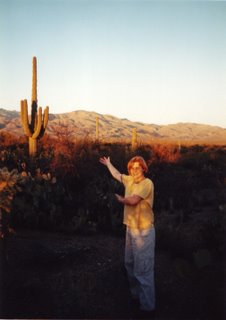 Perhaps the most famous desert in the U.S. is the Sonora, a vast tract extending from Southern California across Southern Arizona and well down into Mexico. It is very diverse in terrain and ecology and, in places, is well-wooded. Ask a 5-year-old to draw a cactus, and she will draw a saguaro from the Sonora. But my favorite two deserts are the rather tiny Mojave, and the rugged highlands of the Colorado Plateau. The Colorado Plateau, having nothing in common with the Mojave beyond dryness, more than deserves its own post. So here is the Mojave. A small desert that I fell in love with long before I visited it just because it has a magic name.
Perhaps the most famous desert in the U.S. is the Sonora, a vast tract extending from Southern California across Southern Arizona and well down into Mexico. It is very diverse in terrain and ecology and, in places, is well-wooded. Ask a 5-year-old to draw a cactus, and she will draw a saguaro from the Sonora. But my favorite two deserts are the rather tiny Mojave, and the rugged highlands of the Colorado Plateau. The Colorado Plateau, having nothing in common with the Mojave beyond dryness, more than deserves its own post. So here is the Mojave. A small desert that I fell in love with long before I visited it just because it has a magic name.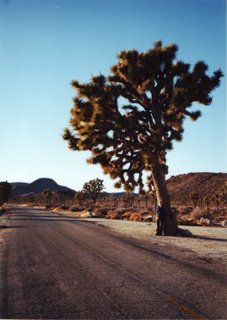 The thing about being out in the open in the Mojave is that you always know just where you are. And most people would say Nowhere, Nowhere At All. And you can see that they are right at a glance, for the Mojave is a land of sprawling valleys that don’t drain out but in — a small salt flat marks the center of each one. In all directions, ten, twenty, fifty miles away, mountains rise out of the plain. Neither high nor steep, these mountains are extraordinarily rugged heaps of fractured rock seemingly without vegetation. Their bare and sunburnt flanks make the valley floors feel verdant in comparison. The iconic plant of the Mojave is neither a cactus nor tree, but a yucca — the Joshua tree [see Kim resting on trunk for scale]. I’ve always thought that Dr. Seuss, who long lived in La Jolla, must have spent time in the Mojave and modeled his distinctive trees on the Joshua tree. Although the J tree is large and inviting, I think that my favorite plants of the Mojave are the chollas, particularly the Diamond and the Teddy Bear.
The thing about being out in the open in the Mojave is that you always know just where you are. And most people would say Nowhere, Nowhere At All. And you can see that they are right at a glance, for the Mojave is a land of sprawling valleys that don’t drain out but in — a small salt flat marks the center of each one. In all directions, ten, twenty, fifty miles away, mountains rise out of the plain. Neither high nor steep, these mountains are extraordinarily rugged heaps of fractured rock seemingly without vegetation. Their bare and sunburnt flanks make the valley floors feel verdant in comparison. The iconic plant of the Mojave is neither a cactus nor tree, but a yucca — the Joshua tree [see Kim resting on trunk for scale]. I’ve always thought that Dr. Seuss, who long lived in La Jolla, must have spent time in the Mojave and modeled his distinctive trees on the Joshua tree. Although the J tree is large and inviting, I think that my favorite plants of the Mojave are the chollas, particularly the Diamond and the Teddy Bear. 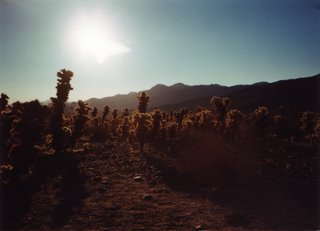 These cacti grow in long chains of linked segments that branch again and again at odd angles, and the whole is thickly covered with fierce spines and needles. The defense is so formidable that they are a favorite nesting site for wrens seeking protection from predators attacking either from ground or air. And then, briefly in the spring, these rugged cacti put out large, bright, but surprisingly fragile flowers.
These cacti grow in long chains of linked segments that branch again and again at odd angles, and the whole is thickly covered with fierce spines and needles. The defense is so formidable that they are a favorite nesting site for wrens seeking protection from predators attacking either from ground or air. And then, briefly in the spring, these rugged cacti put out large, bright, but surprisingly fragile flowers.The largest animal you can expect to see in this desert is a coyote. But I wouldn’t blame you if you thought that maybe the antelope jackrabbit was bigger. For truly big there were, and still just barely are, desert Big Horn sheep. But you need to go to a lot of bother to have any hopes of seeing one. Mostly the mammals are small. I once made the mistake of setting a bag of groceries on the ground for a few minutes one evening and then spent two days trying to find and evict a kangaroo rat from my truck. I don’t care to listen to them eating my tortilla chips all night, but kangaroo rats can be cool. Under a full moon, you can watch them bound through your campsite, darting out from the shadows and then back in with an enchanting mix of boldness and timidity driven equally by hunger and fear of predators. The mammals have the night, but lizards rule the day. At least by numbers. They do zip about ever fearful of the birds. There are all kinds and sizes of lizards. Most of them are small and dark, and very fast. One will pause on a hot rock doing its funny little pushups and then dash out of sight. But my favorite is a very large lizard, the chuckwalla. This is a kind of squashed looking chubby creature with lots of loose skin. It is not very fast, but has the clever trick of being able to balloon itself up. So if threatened, it retreats into a rock cleft or hole and then inflates to wedge itself tight enough that the predator cannot pull it out. Who could help but like an animal named a chuckwalla?
The Mojave’s problem is that it is an accessible desert. It is being chewed away from the west by the inland sprawl of coastal Southern California. And it has an indigenous city that has exploded from a small dusty outpost into a huge water hungry monster. Not allowed what it wants from the nearby Colorado River, Las Vegas has been mining fossil water put down in the last ice age. The most famous place in all the Mojave, Death Valley, is not yet dead — it even has fish — because it is fed by springs from the same ancient water. But Death Valley will soon die as it is sucked dry by the lawns, golf courses, and fountains of Vegas.
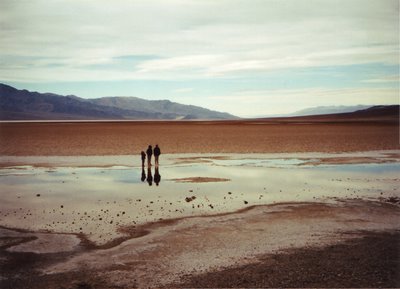
And the flat open expanses of the Mojave can be driven. So they have been, and still are. There are roads and tracts all through the desert that have opened it to all kinds of abuse. On the largest scale is the military. Soldiers plowed tanks through the friable soils while training for war in North Africa, and, a half century later, for more war in the Gulf. There are artillery ranges and bombing ranges and huge Air Force and Marine bases. And there is even the mysterious Area 51. Mining has scarred the land on scales from mountains that have been blown up and turned inside out, down to random small holes dug by speculating prospectors. Those who found something would then dig a bigger pit and haul off a few truckloads — maybe even legally. Most astonishing are the land scams where settlers were set up with 640 acres under the Homestead Act. You can see grids of dilapidated huts — about the size of a one-car garage — marking out the edges of these small waterless “farms.” I always wonder what the poor saps thought when they were first shown their new homes on land with no prospect for a livelihood whatsoever.
Anything you can imagine hauled out into the desert is there. And there is even more stuff that you could not imagine. Nothing rots or rusts. Nothing sinks out of sight in the mud, or gets covered in vines. It all just sits there fading in the sun. Paint blisters and fabric tatters, and maybe the odd bit of something will break and fall off. But mostly it all just sits there in mute testimony of human comings and goings, just hinting at the hopes and despairs, insane plans and spectacular failures, of generation after generation. Small for a desert, the Mojave must be our largest, most amazing junkyard.
Sadly though, one icon that should have slowly moldered away forever is gone — the Mojave Phone Booth. You have seen the booth since it appeared in many movies. Even more famous than Dr. Who’s red box, the Mojave Phone Booth was a destination for many a world traveler eager to make a call home from the middle of nowhere.
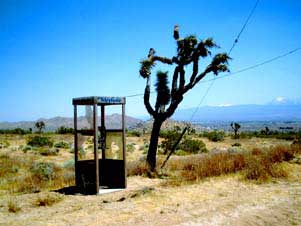

18 Comments:
I don't know why, but for some reason the desert seems very clean to me. Maybe it's just the fresh air. Or the fact that there's no evidence of other humans for miles around in many places (OK, that's not it -- I'm usually underwhelmed driving through the Flint Hills).
I just remember driving to Colorado Springs on Labor Day weekend for the OU/Air Force game. In the middle of northeast New Mexico I just wanted to turn my car off the highway at a nice spot in that beautiful desert next to a mesa and a river (If I hadn't had two sports writers and a photographer with me, maybe I would have done it).
And let me explain my love of Vegas: After working until 1 a.m. in not only Tallahassee and Tulsa but also Boston and Los Angeles, Vegas is still the only place I've come across where there's plenty to do once a night desk shift ends.
Well, yeah, Vegas is good for staying up all night. No doubt. And when you're there you feel like anything goes, and that's very refreshing ... but it is a monstrous blight on the environment.
Last time I was there was on the way home from a camping trip in the Southwest. After days of tent living in the desert, it was nice, in a selfish way, to take a shower at the Stardust Hotel and gorge on a hot buffet, but it also struck me as very obscene - the waste of resources, the drain on the environment to power miles of neon, the whorish lighting everywhere, the dancing fountains of the Bellagio that mock the lack of water.
It was like Bartertown. Bust a deal - face the wheel.
Oh, and DW, I was kidding about your hair. I love your hair, doll. And I love that you are squatting on my blog.
I thought Tempe was lovely, if too suburban, and Flagstaff even more so when I took that road trip with friends I told you about Tuesday. I think it's the lack of humidity or mountains on the horizon; I'm not sure which. I'd love to see desert-desert and not the scenic route off major highways and pitstops.
I also stand by my comments from Tuesday about Maine, but my mom's family is from there, generations back, and I think that's part of the inexplicable affinity.
There's also something to be said about being alone without anybody around ... not that it would be the same if we started a settlement a few miles outside of Hoisington.
No, it's just not the same.
That’s ok KC—I can read from context, you know. I figured you had no desire to inflict a 9-to-5 on me, and then there were those pigs....
George, let’s just drop a big meteor on Vegas, and then we can move to San Francisco. Now there is a truly worthy twenty-four city. It is exactly where a city should be (never mind those little earthquake faults). And even though it has been much damaged by the skyscrapers and the freeway, it remains beautiful. It is my favorite American city, but I have no plans to ever make enough money to live there.
San Francisco ... that's another place I need to visit. I remember going there as a very young boy, and I remember really liking it there. Yet another place I need to visit.
I spent the better part of a winter in Flagstaff with some lovable lowlifes who are even more averse to having regular jobs than I am. One of them would have been a chain pot smoker except he couldn’t ever buy any weed. So he walked around firing his empty pipe hoping to find somebody who would take pity and give him a bud. As you might guess, this household wasn’t into any extravagances like heating the house beyond what it takes to prevent the pipes from breaking, if even that. When it got really cold, I bailed out of that high country—known as the Mogollon Rim—and drove back down into the desert for some warmer climbing.
I do like Flagstaff. I hate Phoenix and its suburbs. I kind of like Tucson, but less and less as it becomes more and more like Phoenix. The mountains east and south of Tucson are wonderful. And there is great climbing back in there to boot.
KC, did you drive between Joshua Tree National Park and Death Valley? If so, when did you do it? The Mojave Phone Booth sounds like just your sort of thing. Was it gone already?
Wow. I've only been to San Francisco once, and it was kind of a short, weird trip, but the city struck me as sort of melancholy ... I could see why Kerouac described its mood as "end of the land sadness." I had a feeling that this is all there is, this is it, this is where the country ends. But it is beautiful. Maybe I would feel sunnier about it if I had seen more of the legendary gay scene there, the "end of the world gladness," as it were.
On that trip I did fall in love with the coastline by Carmel.
I recently read an awesome essay comparing the great SanFrancisco earthquake of 1906 with the current devastation in New Orleans. It's amazing how much the two cities have in common — both American jewels, SF of the West, NO of the South, similar size, both with bawdy reputations. In both cases it wasn't the disaster that wreaked so much hell as what came after, mainly because of human error — in SF, it wasn't the quake but the fire afterward that caused so much misery; in NO, it wasn't the hurricane itself but the flooding when the levee broke. The big difference was that SF was a young city when disaster hit and still had a lot of energy to rebuild; NO, by contrast, at 300 years old, was a decaying old queen.
I've never been to New Orleans. I still get teary when I read stories about it and think of the stuff there I'll never see.
I like flagstaff, too. It has attitude. We ate at a barbecue place there late one night — it was the day after Christmas — and our waiter was a 9-year-old boy. It's the kind of place where child labor, and other "laws," are taken with a grain of salt.
Tucson I thought was very beautiful. That picture of me with the saguaro was taken near there.
Yes, I drove between Joshua Tree and Death Valley, three or four years ago. I don't remember seeing any phones, but most of that trip was at night.
KC,
Have you seen the documentary about the San Francisco troupe of hippies and drag queens, The Cockettes?
Here’s what wikipedia says about them:
The Cocketters were credited at the time with being a huge influence on gay liberation: The term “genderfuck” was coined about them to express what one might make of a drag queen with a beard and a glittered penis.
They were a big hit in SF, but when they took the show to New York City, they bombed. Just goes to show you that NYC is much more provincial than it pretends to be.
KC, maybe you weren’t the only one to drive past the phone booth at night. Maybe Jean Baudrillard did as well. One of the things that I found fascinating about his book is that he would never have written an account anything like mine. It never once occurred to him to wonder how and where all these cities on the desert got their water, for instance. He hadn’t the slightest interest in structure or function. For him, all was sign. I can only imagine what strange and evocative things he would consider the Mojave Phone Booth to signify.
You really have a thing for that phone booth, don't you, dear?
I'll find a picture later and add it to the post. (can't do from this computer)
I had had nursing on my mind for about a year when Katrina hit. When the J-W ran those stories from nurses and all the work they were doing, that's what just about sealed it for me. (That and DA's idiocy.)
I remember the first time driving through Flagstaff. It was night and snow was everywhere. Very pretty.
One fall I took a climbing trip with a nurse from Portland. She had been working for a small practice that was going to go bankrupt and dissolve at the end of the year. She convinced them to lay her off in October instead of waiting to December. That way we were able to take a trip during better weather. She was seriously considering moving to a small town in the desert; she said they always needed nurses. So while the unemployment office thought she was looking for work in the sense of contacting potential employers, she was actually looking in the sense of potential towns. Bending the rules a bit, I guess. In the end she decided that she wasn’t up to such a big jump and stayed in Portland. Portland would be a hard place to leave, but I bet she would also have liked spending a few years out there somewhere.
But in any case, we had a great trip driving around in her vintage yellow VW bus and visiting her identical twin sister in Albuquerque.
The Cockettes attempt to play New York would have been after the Stonewall Riots. And NYC was perfectly ready for a big show of drag queens. The only problem was that they had their own queens who were refined and sophisticated. The Cockettes showed up and were anything but.
I wonder if Frank Zappa—who lived as teenage in the Mojave, by the way—was also not as popular in NYC as he was on the West Coast.
KC, if Liberty Hall doesn’t have the Cockettes documentary, then add that to your reasons to do NetFlix.
DW, I added a phone booth picture for you.
Good.
And expanding on the Zappa theme, Captain Beefheart lives in the Mojave too.
Post a Comment
<< Home